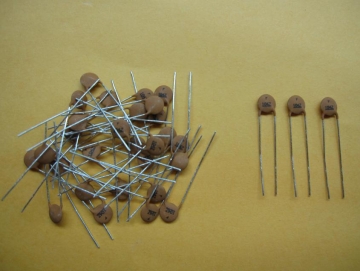News
- 2010-09-08 17:08:27
-

Fixed leaded disc and multilayer ceramic capacitors(MLCC)
A ceramic capacitor is a fixed capacitor with the ceramic material acting as the dielectric. It is constructed of two or more alternating layers of ceramic and a metal layer acting as the electrodes. The composition of the ceramic material defines the electrical behavior and therefor the application of the capacitors which are divided into two stability classes:
•Class 1 ceramic capacitors with high stability and low losses for resonant circuit application
•Class 2 ceramic capacitors with high volumetric efficiency for buffer, by-pass and coupling applications.Ceramic capacitors, especially the multilayer version (MLCC), are the most produced and used capacitors in electronic equipment with a produced quantity of approximately 1000 billion pieces per year.
Classes of ceramic capacitors
Three classes of ceramic capacitors are commonly available
Class I capacitors: accurate, temperature-compensating capacitors. They are the most stable over voltage, temperature, and to some extent, frequency. They also have the lowest losses. On the other hand, they have the lowest volumetric efficiency. A typical class I capacitor will have a temperature coefficient of 30 ppm/°C. This will typically be fairly linear with temperature. These also allow for high Q filters—a typical class I capacitor will have a dissipation factor of 0.15%. Very high accuracy (~1%) class I capacitors are available (typical ones will be 5% or 10%). The highest accuracy class 1 capacitors are designated C0G or NP0.
Class II capacitors: better volumetric efficiency, but lower accuracy and stability. A typical class II capacitor may change capacitance by 15% over a −55 °C to 85 °C temperature range. A typical class II capacitor will have a dissipation factor of 2.5%. It will have average to poor accuracy (from 10% down to +20/-80%).
Class III capacitors: high volumetric efficiency, but poor accuracy and stability. A typical class III capacitor will change capacitance by -22% to +56% over a temperature range of 10 °C to 55 °C. It will have a dissipation factor of 4%. It will have fairly poor accuracy (commonly, 20%, or +80/-20%). These are typically used for decoupling or in other power supply applications.
At one point, Class IV capacitors were also available, with worse Electrolytic Capacitor characteristics than Class III, but even better volumetric efficiency. They are now rather rare and considered obsolete, as modern multilayer ceramics can offer better performance in a compact package.
These correspond roughly to low K, medium K, and high K. Note that none of the classes are "better" than any others—the relative performance depends on application. Class I capacitors are physically larger than class III capacitors, and for bypassing and other non-filtering applications, the accuracy, stability, and loss factor may be unimportant, while cost and volumetric efficiency may be. As such, Class I capacitors are primarily used in filtering applications, where the main competition is from film capacitors in low frequency applications, and more esoteric capacitors in RF applications. Class III capacitors are typically used in power supply applications. Traditionally, they had no competition in this niche, as they were limited to small sizes. As ceramic technology has improved, ceramic capacitors are now commonly available in values of up to 100 µF, and they are increasingly starting to compete with electrolytic capacitors, where ceramics offer much better electrical performance at prices that, while still much higher than electrolytic, are becoming increasingly reasonable as the technology improves.
- Previous [Return Home] [Print] [Go Back] Next
Contact Us
Contact Person:
Miss Li MeizhenTel:
86-769-82825339- 82825369
- 18929453899
Fax:
86-769-82829959Email:
nanalee.mc@163.com


